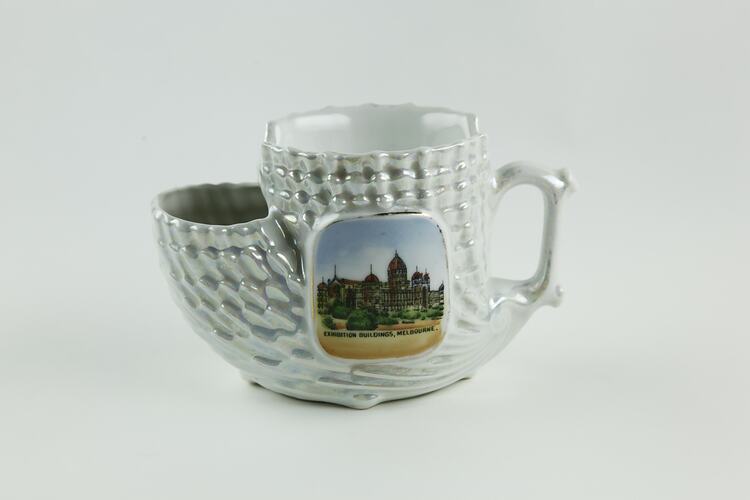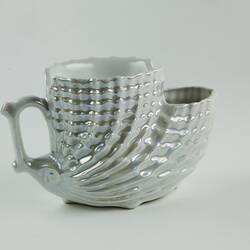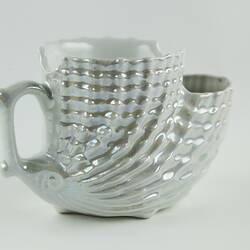Summary
Ceramic lustreware shaving mug fashioned in the form of a paper nautilus shell and depicting the Royal Exhibition Buildings, Melbourne, manufactured by the 'Victoria' Schmidt & Company in Stara Role, Czechoslovakia, between circa 1918 and 1938.
'Victoria' Schmidt & Company was founded in 1883 by Lazarus and Rosenfeld Ltd., but sold within two years to Franz Schmidt who subsequently gave his name to the firm. Originally founded in the north-western Bohemian town of Altrohlau, then part of the Austro-Hungarian Empire, Bohemia was separated from Austria to become part of Czechoslovakia at the end of First World War, Altrohlau changed its name to Stará Role. Schmidt & Company ceased to exist in 1945, when they merged with the Altrohlau Porcelain Factories and the EPIAG factories (Erste Bohmische Porzellanindustrie A. G. In Karlsbad, the First Bohemian Porcelain Industries in Karlsbad, a joint-stock company of Czech porcelain manufacturers), to become known as Starorolský Porcelán. In 1993, Czechoslovakia split peacefully into the Czech Republic and Slovakia.
Schmidt & Company were known for their large commercial production and items such as this one illustrate one aspect of the firm's production of cheap, commercial souvenir items for the export market. Several similar souvenir items depicting Australian scenes are known, produced by 'Victoria' Schmidt & Company during this inter-war period.
Physical Description
Ceramic lustreware shaving mug in the shape of a shell, with transfer print of the Royal Exhibition Buildings, Melbourne, on the side. On the underside is printed the monogram of the 'Victoria' Schmidt & Company used during a twenty-year period from approximately 1918-38, and several, overlapping dark blue pigment marks.
Significance
This shaving mug represents the diversity of the types of souvenirs relating to the Exhibition Buildings during the first half of the twentieth century, as well as illustrating the growth market for off-shore, mass-produced commercial items.
It also aptly illustrates the prominence with which the Exhibition Building held in the early decades of the twentieth century as a major Melbourne tourist attraction, prior to the building's diminished reputation in the middle of the century when it faced the threat of demolition.
More Information
-
Collecting Areas
-
Acquisition Information
Purchase
-
Manufacturer
'Victoria' Schmidt & Company, Stará Role, Czechoslovakia, 1918-1938
-
Place & Date Depicted
Royal Exhibition Building (REB), Melbourne, Greater Melbourne, Victoria, Australia, 1918-1938
-
Inscriptions
Printed on underside: Victoria/ [crown]/ Czecho-slovakia
-
Classification
Royal exhibition building, International exhibitions, Exhibition heritage
-
Category
-
Discipline
-
Type of item
-
Overall Dimensions
15.3 cm (Length), 8.5 cm (Width), 9.7 cm (Height)
-
Keywords
Royal Exhibition Building, Souvenirs, Ceramics, Personal Grooming, Haircare, Shaving






